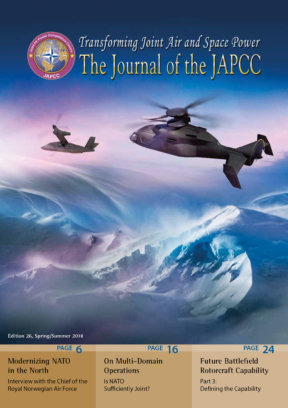Editorial
After four thrilling years in Kalkar, my tour as the JAPCC Assistant Director and my time as the Editor of this Journal ends in August 2018. Editing the Journal was probably one of the most time consuming, but rewarding, tasks I had in my entire portfolio. The countless contributions we received from authors throughout the Alliance, and even beyond, were thought-provoking, innovating, educational, but most of all down-right great reads. I thank all of you, readers and authors alike, that have helped make this journal such a valuable asset in JAPCC’s transformational toolbox.
This said, I am particularly excited about the Journal issue in front of you. It kicks off with a highly enlightening interview with Major General Tonje Skinnarland, Chief of the Royal Norwegian Air Force. Sharing with us her views on Norway’s demanding path towards modernizing NATO in the North, she elaborates on the challenges of integrating fifth-generation capabilities to include new C2, competence and mindset requirements at the joint level. Her insight acts as a natural springboard for the two follow-on articles. In the first, Major General (ret.) Tim Zadalis explains how advanced Multi-Domain C2 (MDC2) could enable commanders to leverage enhanced decision-making capability to direct forces across domains and missions. The second provides a JAPCC perspective that very thoroughly, and critically, examines whether NATO, at this point of time, is sufficiently joint to begin earnest discussions regarding MDC2.
In this Edition we then move on to other significant transformation and capability topics, such as the future of close air support, suppression of enemy air defence, rotorcraft fleets, and automated air-to-air refuelling. Additionally, a duo of Anglo-French authors present their viewpoints about fourth- and fifth-generation integration challenges for F-35 partners, as well as implications for Alliance nations not participating in this transformation process. A very appropriate companion piece from the European Air Group explains how its Combined Air Interoperability Program could help solve such generational integration issues. Switching gears to missile defence, our Journal elaborates on options to enhance the European contribution to the Alliance’s sea-based missile defence capabilities, followed by an essay about the role of ballistic missile defence in NATO deterrence. We close with an article illuminating hybrid warfare and NATO’s current approach to countering hybrid threats.
Thank you for taking the time to read this edition of our Journal. I congratulate the authors on their contributions and I strongly encourage our readers to consider sharing your thoughts as you go forth and advocate for Air Power. The JAPCC team greatly appreciates your feedback and thoughts. Please visit our website at www.japcc.org, like us on LinkedIn or Facebook, or follow us on Twitter to give us your opinion. With your continued interest and support, the JAPCC Journal will remain in the vanguard of Airpower dialogue!
Madelein Spit
Air Commodore, NLD AF
Assistant Director, JAPCC








